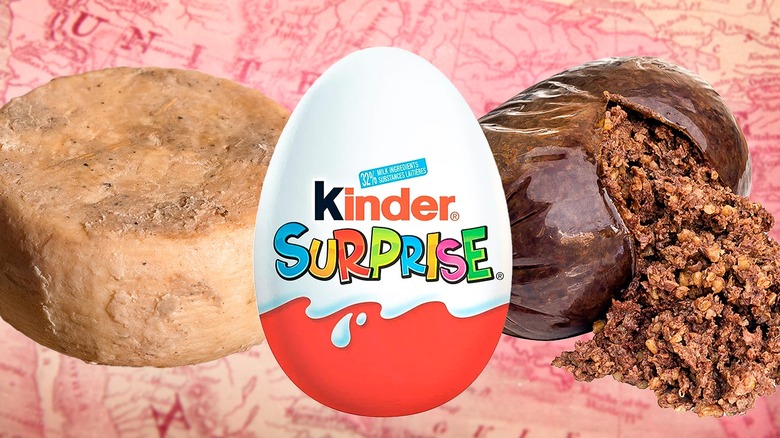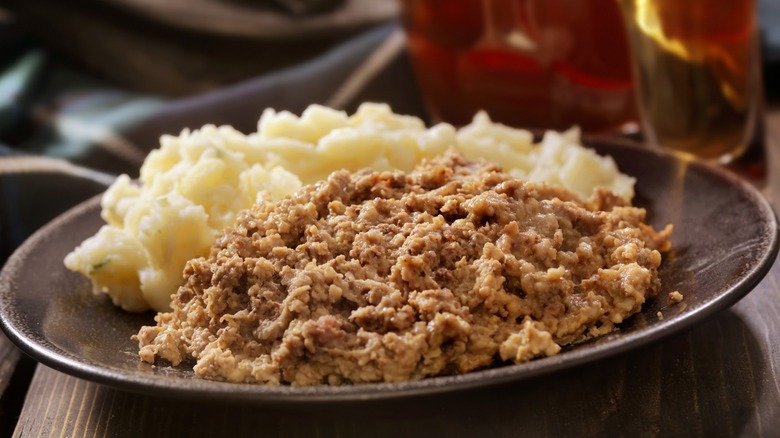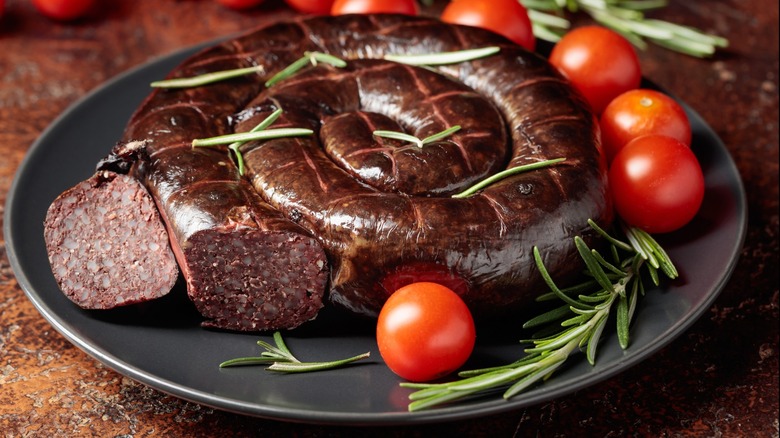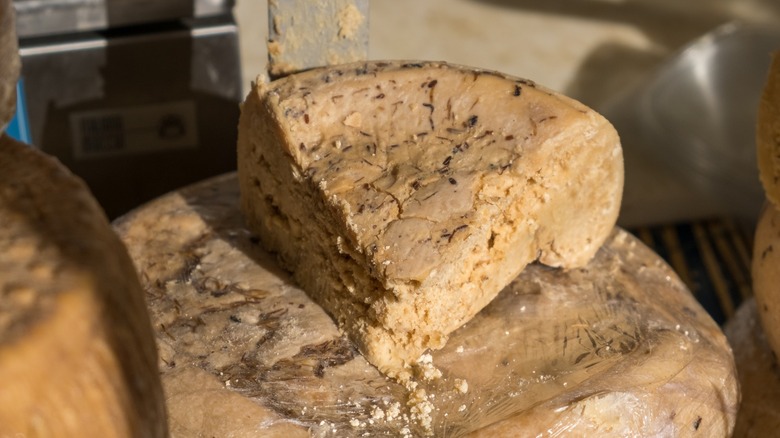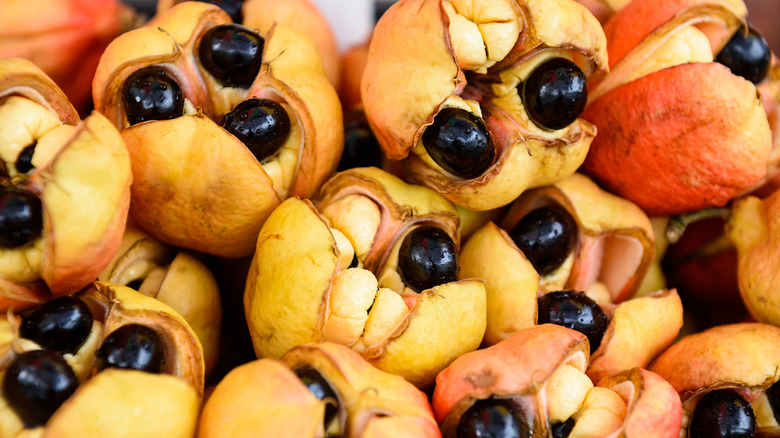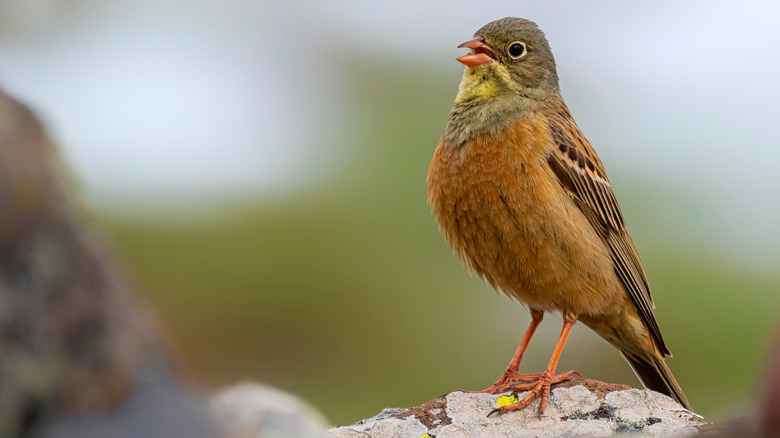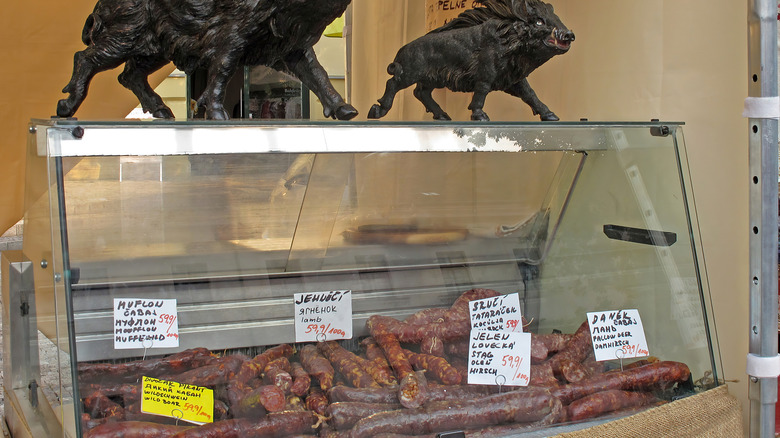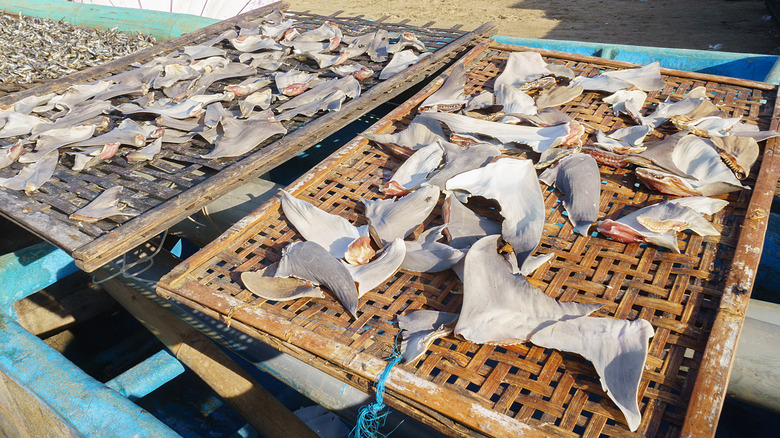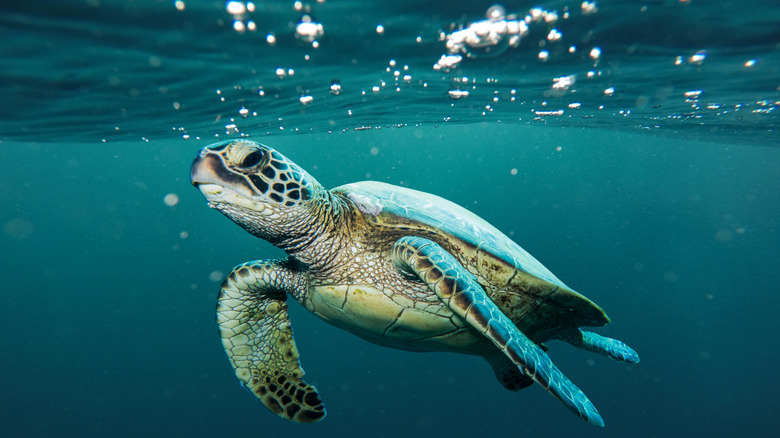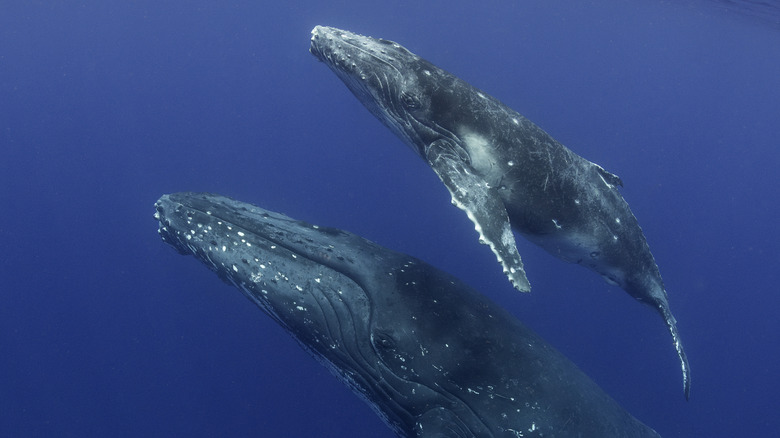10 Foods From Around The World That Are Banned In The US
The United States is globally renowned as a melting pot of cuisines. Nowhere is this more evident than the American dinner table, which often features a smorgasbord of international delights. But not every dish from around the world makes the shopping list. Many Americans frown upon adding certain edibles to their diets, like horse meat. Other global delicacies don't make it past local and state ordinances, like California's bans on controversial foie gras and even certain food dyes. And then there are the ingredients that don't make it through customs at all, from sheep's lung to lethal fruits.
Of course, it's still true that Americans have access to a wide variety of foods to sate their palates. But plenty of thingas are banned due to cruelty, scarcity, toxicity, and even changing taste buds. What are these foods that have been banned, and why have they merited such harsh punishment? We've done some online digging to create this breakdown of 10 foods Americans won't see at the supermarket any time soon.
Haggis' sheep lungs may cause foodborne illness
When actor Mel Gibson ventured to Scotland to film "Braveheart" in the early 1990s, the star took the opportunity to try a meal banned in the U.S: haggis. As reported by The Scottish Sun, Gibson loved Scotland's national dish so much, he overindulged. "I had a six-pack back in those days. I did try the haggis. I ate it," the star remarked. "I like it ... but I think it does make you porky. I've got a one-pack now. So I really ought to back off the haggis."
Haggis may pose this hazard to movie stars, but this isn't the reason why the dish isn't available in the USA. One major ingredient of this Scottish fare is sheep lung, which is boiled in the animal's stomach during prep. The FDA has banned lungs as an ingredient in any meal because lungs are vulnerable to food borne viruses. While haggis can be made domestically, it won't have sheep's lungs, which some discerning diners might consider to be that special something that makes haggis taste like the real deal. William Wallace might say (with a deep sigh of lament) that without tasting authentic haggis, a man might not have really lived. Americans will just have to make peace with that.
Fresh black pudding is too rich in blood
Ah, black pudding — one of the mainstays of the British diet. According to legend, King Arthur made a hearty black pudding that he and the Round Table gorged upon. But many Americans have no idea what the big deal is. They might even assume it's some sort of chocolate dairy dessert. In fact, black pudding is a sausage heavily infused with blood from a pig or cattle. Hence the color, which makes it stand out from the similarly-named white pudding.
Unfortunately, the heavy use of blood makes black pudding unknown in the United States. Manufacturers of blood-laden food must register with the FDA for pre-approval, with a detailed list of all products, their agent in the United States, the importer and its representatives, and the processes used. For Americans abroad, the USDA allows blood sausage in personal baggage only if it has been commercially cooked and sealed in a can or jar — no fresh stuff.
Even if an importer decides to fill out and submit their paperwork, black pudding might not make it through customs. Traditionally, sausages contain organs, including lungs; one 1695 cookbook's recipe for black pudding calls for a combo of lungs, hearts, livers, and the surrounding flesh, all minced and seasoned to taste. Like haggis, the use of lungs places imported black pudding on the blacklist, although domestic producers can readily make their own.
Casu marzu contains live maggots
"Rotting cheese" might not seem like a catchy name for an international delicacy, but in Sardinia, the term translates to casu marzu. It lives up to the moniker: This cheese is home to an infestation of live maggots.
While Americans may think twice before grubbing on grubs, casu marzu has a rich legacy in the Mediterranean. As folklore has it, in the days before refrigeration, spoiled pecorino cheese became infested with maggots. Hungry shepherds without any other options had to chow down. Fortunately, the pungent aroma and creamy texture struck their fancy, and a new favorite dish was born. Fast forward to the 21st century, and dairy farmers have perfected the art of attracting cheese skipper flies to settle down and lay their eggs.
Tastes certainly vary, but there's nothing wrong with eating insects. It might seem excessive, then, to make casu marzu illegal in the U.S. simply because of wriggling grubs. However, these maggots don't necessarily get digested. And if they do, in fact, survive the stomach's gastric acids, these hardy insects can wreak havoc in the intestines. Thus, the ban.
While illegal in the U.S., the European Union, and even Sardinia, fans and curious eaters can still readily find casu marzu in local shops and small, maggot-made batches in niche markets.
Raw ackee's amino acids make it a health hazard
Fruit is always good for you — right? Wrong. When it comes to American tables, there's one fruit too dangerous to make an appearance among the kiwi and pineapples: the ackee.
Ackee is the national fruit of Jamaica. But despite coming from such a close-by region, ackee can't be imported into the U.S. The fruit certainly looks like a colorful contender for the produce section, with its warm red and yellow flesh and shiny black seeds. Unfortunately, ackee — rather like its pronunciation suggests — can be a choking hazard. When bitten, ackee releases an amino acid that induces hefty vomiting, wreaks havoc with blood pressure, and can cause death.
The takeaway here is: Don't eat raw ackee found in the wild. But for Jamaican-Americans and curious fruit-lovers, there are safe and legal ways of enjoying this fruit. Canned ackee is thoroughly cooked, meaning that the toxins have been boiled out, leaving it safe to eat. If you're looking to make a showstopper for a Caribbean-themed feast, pair ackee with salted fish or pork — it's one Jamaica's most beloved recipes.
Orlotan is cruelly slaughtered
There's not much meat on the ortolan bunting, but it's an icon of French cuisine. This is due to the burst of fatty flavor that erupts when diners chow down on the songbird. Enjoying it is controversial, however. The migratory bird is only available in Western Europe during the summers. Once caught, it's kept in the dark and force-fed grains and figs. Once their size has ballooned to twice their natural weight, these plump birds are unceremoniously drowned in Armagnac brandy. Ortolan might be a delicacy, but to many, it's too cruel to try.
The controversy doesn't end with the cooking process. The orlotan is consumed whole, bones and brains included, leaving only the beak. As a courtesy, the diner masks his face with a towel when performing the act, perhaps out of penance, or maybe to prevent the juices from spurting out. This entire indulgent experience doesn't happen very often anymore, though: Selling orlotan is illegal in the U.S. and the European Union, which includes France. As for the tiny songbird, over-harvesting — often fueled by black market demand — has had a serious impact on its numbers.
Bushmeat must stay in the wild
Any safari adventurer can enjoy an unforgettable luxury meal in the Kenyan hinterlands. But eating actual bushmeat is an entirely different sort of culinary experience. In many regions where growing food and raising livestock is impractical or costly, the only alternative is to hunt wild animals, including snakes, bats, and monkeys. Wild animal meats from African wetlands, jungles, and grasslands are collectively called bushmeat. Anyone interested in sampling this wild fare must seek out local establishments and street sellers; U.S. customs officials confiscate and destroy all bushmeat would-be importers try to bring over the border.
That's not all: Any non-food personal possessions that might have come in contact with the meat are also seized and destroyed. Moreover, the unlucky traveler is slapped with a $250,000 fine. The reason? Aside from the endangered status of many animals, bushmeat, like most wild meat, risks spreading disease. Bushmeat is usually prepared through salting and drying processes, which don't remove harmful bacteria. Thus, it poses a risk of spreading such dangerous illnesses as ebola. So, if you're tempted to try meat from antelopes, rhinos, or lemurs, make sure the meat is thoroughly cooked onsite — and don't bring it home.
Harvesting shark fins has damaged populations
In 2022, the U.S. Senate passed the Shark Fin Sales Elimination Act, making it illegal (with a couple of exceptions) for anyone to sell or buy shark fins, or products that contain shark fins. These fins are an age-old ingredient in many Asian cuisines and medicines; they're said to have many health-improving properties. What, then, makes shark fins controversial? Well, the trade in fins is so intense that many shark species are now endangered.
Harvesting shark fins also leaves the wounded animal to die in the ocean depths. As Rebecca Regnery, deputy director of wildlife at Humane Society International, vividly described, "Shark finning is like cutting off your limbs and leaving you to bleed to death." Without the ability to swim, due to the fin's absence, sharks can't eat, breathe, or protect themselves from other predators. They are, in other words, literally dead in the water. Shark fin soup may be popular, but sharks all over the world probably wish we'd turn our tails.
Sea turtles went from luxury dining to endangered species
When Alice confesses her ignorance concerning mock turtles in "Alice in Wonderland," the Queen of Hearts patiently explains, "It's the thing Mock Turtle soup is made from." This quip is a vivid indicator of turtle soup's then-huge popularity among diners — it was so big, "mock turtle" soup had to be invented. Sea turtle soup was a symbol of fine dining as far back as the 1700s. But overharvesting and habitat destruction took a huge toll on the animal's population. Eventually, sea turtles were given legal protection, which extends to their breeding grounds and eggs. Selling, buying, or transporting sea turtles are all also illegal.
If the urge to try turtle soup strikes, diners can still find it available on some restaurant menus, and turtle meat can be readily ordered online. But all these turtles are farmed domestically, and they aren't sea turtles — snapping turtle meat is an especially common option. As for the Mock Turtle of Wonderland — well, he might wish he was the real deal, but he also laments his lost brethren who ended up as soup.
With one exception, whale meat remains off the chopping block
Had he lived today, Captain Ahab would be devastated: The great white whale he hunted for so long enjoys protection under the Endangered Species Act. While it was once a major resource hunted by thousands, it is now rarely seen on menus. This isn't just the case in the U.S., either — whale isn't what it once was anywhere. Even vending machines haven't been able to make whale meat trendy again in Japan, where it has a seriously lengthy history.
Whalers have only themselves to blame for the over-hunting that led the U.S. to ban whaling in 1971.For those who want to take a bite, it's technically possible to eat whale meat, but only in incredibly specific circumstances. Selected native communities in Alaska are allowed to hunt bowhead whales for food. For these groups, hunting, preparing, and eating whale meat is respected by law, and accepted guests may presumably partake in the time-honored tradition. However, don't expect to find a loophole that will let you take any home. Selling and buying whale meat on the open market remains illegal for everyone.
Chocolate and plastics don't mix for Kinder Eggs
Back in 2017, American chocolate connoisseurs were overjoyed to learn that Kinder Eggs were coming to the U.S. These kid-centered treats had occupied a special place in the underground candy market for years. But the egg-shaped chocolate confections contain a plastic toy surprise. Unwary consumers might take a too-enthusiastic bite and turn that toy into a choking hazard.
Inserting plastics into food can create an "adulterated" product, which, according to 21 U.S. Code § 342, is illegal to sell. There are ways around it; after all, everything from Cracker Jacks to cereal have contained physical toys and trinkets. But Kinder Eggs don't make the cut. Tourists who unknowingly bring them into the country can face major fines.If you'd like to enjoy a Kinder Egg, there are plenty of places to do it. Some are very close — Canadians enjoy these treats without issue. But be sure you eat them all before coming back over the border.
